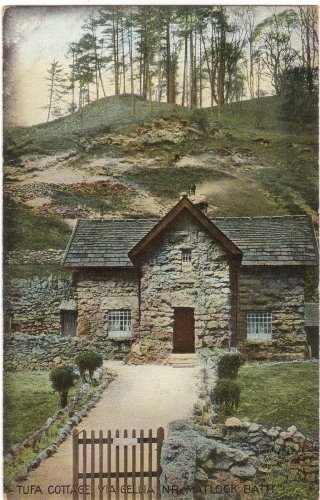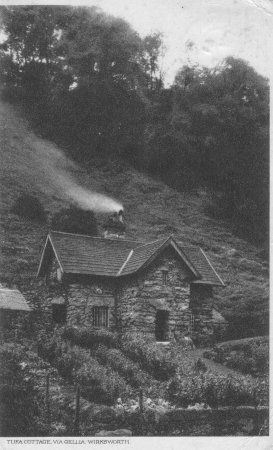Unposted. Notice: Huge lump of tufa as lintel, two more as
gateposts. Tufa outhouse on right and perhaps toilet on left.
Fire from right room, 30 panes of glass in large windows.
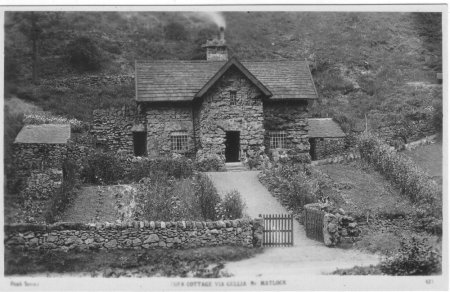
Posted 1917. Redcurrants in the front garden? |
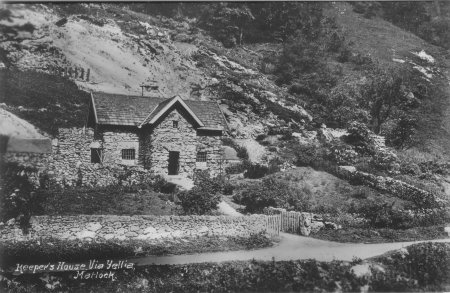
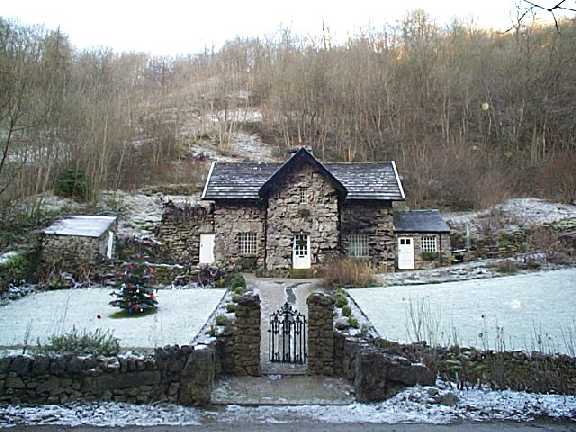
Posted 1911 to Cleasby, Fulham Rd, London. Early charabanc pulled by four greys, driven by 2 coachmen in tall hat and boots. 15 passengers (6 ladies), 1 brakeman, and 1 onlooker. An old car stands by. Presumably an organised day out, up Via Gellia, pausing for the cameraman outside Tufa Cottage. What a fine scene.
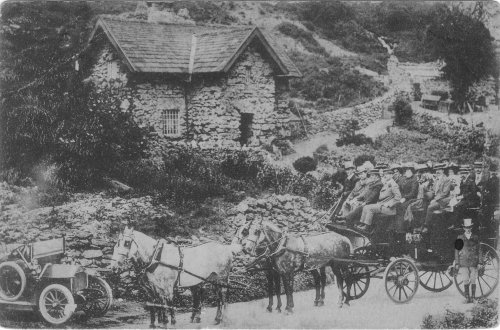
Tufa Cottage, Via Gellia
OS ref: SK 2698-5678
A delightful cottage built of rough blocks of tufa, which has
a very rough texture. Originally a Keepers cottage, built about 1830.
Also once known as "Marl cottage" and "Keepers cottage", it may be the
only house in the country made of tufa. Sometimes called Via Yellia,
the fabric called Vyella may derive from this. The present occupier tells
me that
the keeper's dogs were kept in a wire enclosure to be seen to the right of
the photo, also that the keeper imported a special type of ant to feed his
pheasants, the ants living in the sandy area to the left of the house. The
occupier hopes to get a website going about the cottage shortly called
www.Tufacottage.com
Via Gellia forms the border between Bonsall and Middleton parishes,
and Tufa cottage is just inside Bonsall.
Margaret Howard of Bonsall writes:
Hi John,
The following is the OS reference for the above taken from my very
battered copy of the O.S. 1.25000 First Series, Wirksworth,
Sheet SK25:- SK 269.567.
As one is travelling from Cromford westwards along the Via Gellia (after
the Bonsall road turns off up the Clatterway) towards the Grange Mill
crossroads on which the "Holly Bush" Inn is found, the cottage is sited
at road level on the northern side of the Via Gellia, just before the
very bad bend below Good Luck mine (on the southern side of the Via Gellia
in Middleton parish). Northwards uphill from the cottage is located
Dunsley spring, which presumably was used as a water supply to the
cottage. This spring runs off the volcanic rock found on Bonsall
Leys and was a source of water for Bonsall farmers living on Bonsall Leys.
I understood this cottage to be a game keeper's cottage belonging to the
Keys Estate from Cromford, which was sold off from the estate in the late
1980's early 1990's. I had a friend who lives at Elton whose grandfather
was the last gamekeeper to occupy with his wife the cottage, they retired
to Elton when Tuffa cottage was sold but I don't know their name.
Incidently the Via Gellia was the Cromford/Newhaven Turnpike opened in
1804...Margaret
Inhabitants of Tufa Cottage, as listed in the Census, seem to be: 1901:Edward BROOKS | 1891:Edward BROOKS | 1881:William CHARLTON | 1871:William CHARLTON | 1861:William CHARLTON | 1851:William CHARLTON
Some learned words about Via Gellia and Tufa Cottage.
Tufa is a rough, thick, rock-like calcium carbonate deposit that forms
by precipitation from bodies of water with a high dissolved calcium content.
(Note that tufa is entirely different from tuff, which is a type of rock
consisting of consolidated volcanic ash ejected from vents during a
volcanic eruption.)
Wikipedia
The road from Grangemill to Cromford was constructed through the Griffe Grange
Valley in the eighteenth century by Philip GELL and given the name Via Gellia,
as a consequence of the "GELLs" alleged Roman descent. The purpose was to
improve access between the family lead mines at Carsington and the Cromford
smelter. Now the valley, as well as the road, is more commonly known as Via
Gellia. Whatever name is used, it is one of the most beautiful valleys in the
county and Lord BYRON could have had it in his mind when he wrote "I assure
you there are things in Derbyshire as noble as in Greece or Switzerland"
Dennis Eardley
Early in the nineteenth century there were seven mills set at different levels up a two mile stretch of the Via Gellia from Cromford. The trade name Vyella originated from the fabric that was once produced at one of the textile mills in the valley. On the steep hillside, where the Bonsall road meets the Via Gellia, a skull, thought to be that of a mammoth, was discovered at the entrance to a cave. Further up the valley the Tufa Cottage is most unusual, being constructed of tufa rock formed from dissolved limestone which has been re-deposited in water.
The continuity of the distinctive limestone plateau scenery of the
White Peak is broken by a few deeply incised dales and by a wider
network of shallower dry valleys. Although the valleys are water-cut
features, most are now dry, providing evidence of a change in climate.
During cold phases of the Ice Age, meltwaters from snowfields cut
into the limestone surface forming valley features. When the climate
changed, the volume of drainage water reduced and lacked the capacity
for valley excavation. What little drainage remained now flows
underground through cave and fissure systems, leaving a network
of dry valleys.
The Via Gellia is a steep-sided, narrow, wooded valley running eastwards
from Grangemill to Cromford. Most of the Via Gellia is a dry valley,
although it does carry an ephemeral stream in wet weather. Its curious
name 'Via Gellia', is thought to derive from the name of a local
landowner, John Gell of Hopton, who first drove a road along the valley
floor.
British Geological Survey.
Tufa-in-the-snow, taken about 2005
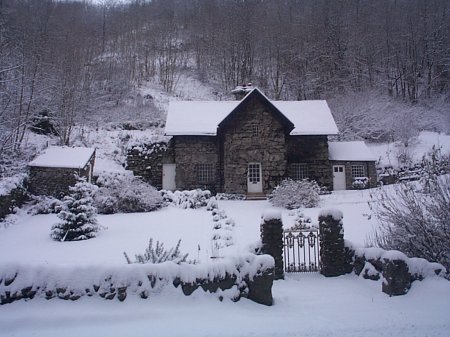 Unposted. The wooded, sandy valley side around Tufa Cottage.
Unposted. The wooded, sandy valley side around Tufa Cottage.
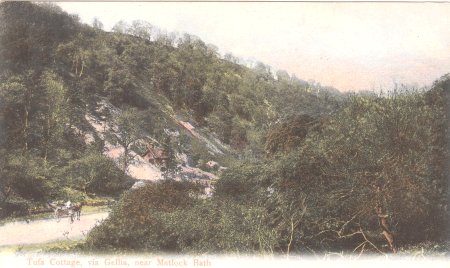
Dates:
Photo taken:
Size:
Source:
Click on photo for enlargement (on CD only)
Have any more information about this photo?
Please e-mail the author on:


